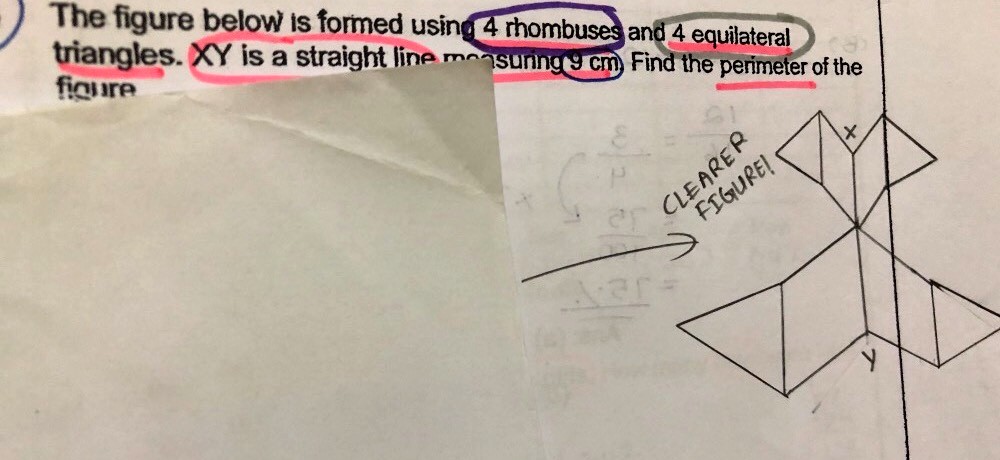Ask Singapore Homework?
Upload a photo of a Singapore homework and someone will email you the solution for free.

Question
primary 6 | Maths
| Geometry
No Answers Yet
Anyone can contribute an answer, even non-tutors.

Pls help, Thanks in advance!
The easiest way is to let the top side rhombus be 3 cm in length and the bottom side rhombus be 6 cm in length.
If you are a good observant, every one short line on top can be paired with one long line at the bottom to combine and form a length 9 cm.
There are four pairs of short-long 9 cm combos, so the total length is 36 cm.
With algebra it’s easier, but I won’t use it since you probably have not learnt algebra in detail yet.
XY is made up of 1 shorter side and 1 lower side. And XY is 9 cm.
Since there are 8 shorter sides and 8 longer sides in total for the perimeter, it should be 9 cm x 8 = 72 cm and not 36 cm.
Furthermore, the lengths of the individual longer and shorter side are not given. We cannot assume as 6cm and 3cm as that is mathematically incorrect. You might incur a deduction of marks.
The purpose of such type of questions is to get students to realise that individual lengths need not always be given/known for solving questions. Many students tend to be too reliant on them and end up getting stuck on such questions.
The proper way to do this is still as J described. We assume a length is unknown because we must show that the figure has the same perimeter regardless of length.
Actually assigning lengths in this makes computation more tedious and time consuming. The working would be as such :
9 = 6 + 3
(or other combinations like 4 + 5, 2 + 7, 3.5 + 6.5 etc)
3 x 8 = 24
6 x 8 = 48
24 + 48 = 72
This takes up 4 steps and relies on assumption of lengths.
The correct method, which tests students to recognise that the lengths should be paired together, would just be :
9 x 8 = 72, which is much faster.
What I see very often is that students try to assign lengths for this questions and then try to add them up together. They would try many different combinations of lengths. Then they will struggle in their attempts to justify why the lengths are such.
This wastes time and they end up realising that it will still amount to the same final answer if they had just paired them up in the first place.
They may also have the misconception that since it 'works' for this question, it will work for other questions as well. Students will repeat this, only to find that they got the next questions incorrect.
Sanjana , for further learning, you might want to take a look for a similar question under the 'unanswered' category by a person with username DS 3 days ago.
The student posted a question on a figure made with a wire bent into 4 equilateral triangles. He/she tried to assign lengths until he got the one that matched the answer but could not prove why they were so and asked for help.
I provided an explanation there in the comments. Hope it can enhance your learning.
Sanjana, follow what J has noted. In proof questions, when you proceed to higher levels, you will need to prove these type of questions using reasoning or algebraic and geometric manipulation.
As a side working on rough paper it would be ok. What's most important is that the steps and working that are actually used on the answer sheet/space is conceptually and mathematically correct.



